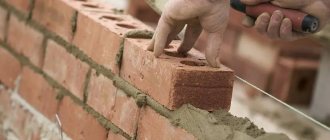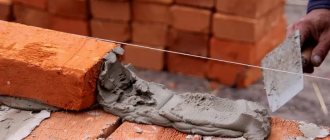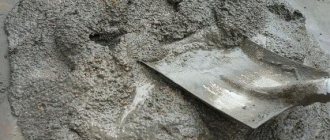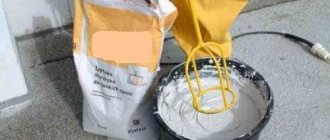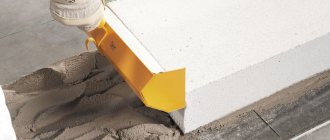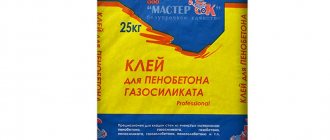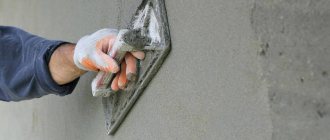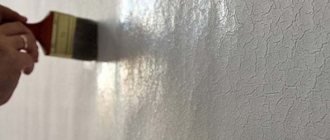Construction is a serious and expensive business. To save money wisely, you need to correctly calculate the amount of building material needed. Therefore, we figure out how to calculate the consumption of mortar per 1 m³ of brickwork - taking into account the ingredients of the masonry mixture and the type of brick.
The consumption of mortar is influenced by many factors, for example, the hollowness of the brick. Source sense-life.com
Types of masonry mixture
There are four main types of masonry mortar used in construction:
- Cement-sand . A classic mixture of cement, sand and water. If the proportions are correct, the solution will be strong.
- Limestone . Here, instead of cement, slaked lime is added. After drying, the seams can “go limp” from getting wet, so usually this mixture is used only for the construction of internal walls and partitions.
- Combined . That is, both cement and lime are added to the solution, which makes it possible to use the solution for the construction of external walls.
- With the addition of plasticizers . In fact, these are all three varieties indicated above, to which a liquid polymer additive is simply added, which increases the plasticity of the masonry mortar.
The most expensive ingredient in mortars is cement. Accordingly, cement-sand will cost the most, since it contains more of this binder. If the goal is to save money, then it is better to choose a combined solution, and for partitions - lime mortar.
The best option is with the addition of a plasticizer. The additive, of course, increases the cost of the solution, but not by much. Plus, the plasticity of the mixture increases, which helps to achieve an accurate thickness of the mortar layer, as well as its uniform distribution over the brickwork.
Classic masonry mortar based on cement and sand Source masteravannoy.ru
The main problem in preparing a high-quality solution is to know exactly and follow the proportions. But recently, manufacturers have made life easier for customers by offering ready-made dry mixtures that simply need to be diluted with water. Mixtures of the M50-M200 brand are suitable for laying bricks. On the packaging, the manufacturer must indicate the consumption of the solution per masonry.
Using online calculators for calculations
If you don’t want to do mathematical calculations, then to quickly calculate the required amount of bricks to build a house, you can use a free online calculator.
By entering the parameters of your future home into the appropriate fields, you can instantly get the desired result. In addition to calculating the required amount of brick, many online calculators allow you to simultaneously calculate other useful parameters, for example, the required amount of mortar for laying walls.
Type of brick
The modern variety of bricks requires a special approach to solving the issue of mortar consumption for brickwork. And if previously wall brick, also known as ordinary brick or solid brick, was mainly used, today manufacturers offer several options.
The first one is hollow. The design of the product contains cavities, which increase the thermal insulation characteristics of the brick wall. But you need to understand that during the laying process these cavities are partially filled with mortar, which increases its consumption.
For example, a solid ordinary brick will require 0.00063 m³ of mortar. For hollow – 0.0007 m³.
Brickwork made from hollow bricks, in general, is no different Source nica-kirpich.ru
See also: Catalog of companies that specialize in the construction of brick houses
The size of the bricks also influences the consumption. Today, three types are used in construction:
- single with dimensions 250×120×65 mm;
- one and a half – 250×120×88;
- double – 250×120×138.
Here the ratio is as follows - the smaller the dimensions, the greater the consumption of mortar per cube of brickwork. In this case, it is necessary to take into account the thickness of the wall itself. And it can be half a brick, a brick, two stones or two and a half. There is no need to make it thicker.
So, if the wall is built using half a brick, then per one cubic meter of masonry, 0.189 cubic meters of mortar will be required. If the masonry is single-brick, then the consumption will be 0.221 m³. For one and a half bricks, which is 38 cm wide, the mixture consumption will be 0.234. At two – 0.24. And at two and a half - 0.245 cubic meters. Please note that the calculations were carried out taking into account ordinary ordinary bricks. And 440 pieces of it are used in one cube of masonry.
Double solid brick Source mastermario.ru
We calculate the number of bricks in 1m2 depending on the type and size
When the need or desire arises to make an additional extension, build a garage, a bathhouse or an entire house, the question arises, what building material to choose? For these purposes, silicate or ceramic is most often used. Any construction begins with the purchase of building materials. But before you buy, it’s worth calculating how many bricks are in a square meter. If you choose, you should calculate how many bricks are in 1 m2. Calculation is needed not only so as not to buy extra material, but because with an additional purchase, there is a possibility that it will be from a different batch (the color will be slightly different). Such a small detail will be very noticeable against the background of the entire masonry. So how do you find out how many bricks are in a square meter?
Selection of construction material
There are few varieties whose characteristics differ from each other. All of them have their own special properties and are used for the construction of both entire objects and individual building elements. Popular on construction sites, the following applications remain:
- Red ceramic (Used for the construction of load-bearing walls, basements and foundations. It has good thermal insulation, moisture resistance, frost resistance, etc.);
- Silicate (has increased strength, is used for the construction of internal partitions in buildings, and is often used to clad the facades of houses).
A separate point should be noted that there are privates and front-line officers. Ordinary is used in the main mass of construction. The front one has smoother edges and is used in the construction of the front part.
Quantity of building materials
Before calculating how many bricks are in 1m2 of masonry, you need to take into account several additional factors:
- The width of the joints (the width of the mortar when laying);
- Size of material used.
Many people do not pay attention to such a small detail as the width of the masonry joint. But per 1 cubic meter. as a rule, it accounts for from 0.2 to 0.3 of the total volume of the masonry. Quite often, builders neglect to take into account the mortar, and when building a private house, the volume of work will be large, which will leave a lot of unused material, so you need to calculate in advance how many bricks are needed.
- Single (spoon part width 250 mm, height 65, butt part width 120)
- One-and-a-half (the width of the spoon part is 250 mm, the height is 88, the width of the butt part is 120)
- Double (spoon part width 130 mm, height 206, butt part width 176)
They exist in other shapes and will have a different number of bricks per 1 m2 of masonry; bricks per 1 m2 of masonry can be calculated using similar formulas. Some of them are special-purpose (from which arches are made), their number can be counted individually, since they are used to a limited extent on construction sites. Other parts are foreign made or made to order.
When builders do not take into account the volume of mortar, they count the number of bricks in 1 cubic meter. calculating the volume of one piece. For example, the dimensions of a one-and-a-half brick are 250 mm. by 120 by 88. We convert the linear dimensions into m² and then into m³, we get 0.25 m * 0.12 m * 0.088 m. We get 0.00264 cubic meters. Now 1 cubic meter, divide by the resulting figure and get 378.78 one and a half. When using single bricks, it turns out about 512 bricks per 1 cubic meter. And if we take the volume of the solution as 0.2, then with one and a half, the quantity is reduced to 300 pieces. With a single one, the quantity is reduced to 400 pieces. It would be a mistake not to take into account the mortar and count brick by brick, especially if the volume of work is large.
Thickness of joints in masonry
Another parameter that affects the consumption of masonry mixture. There are standard dimensional parameters for the thickness of the gaps between bricks, which craftsmen must adhere to. It is these dimensions that ensure the strength of the entire structure. Here are their parameters:
- horizontal seams should have a thickness of within 12 mm;
- vertical 10;
- longitudinal in the range of 12-15 mm;
- transverse 8-10.
It is not always possible to adhere to these indicators. Causes:
- low skill of the workman;
- climatic conditions;
- geometric unevenness of bricks.
The last reason is considered the main one. Most often, this is a criterion for excessive consumption of masonry mixture. To lay the stones evenly, you have to increase the mortar in some areas to hide the unevenness of the blocks.
So, everything is clear with the thickness of the seam. The thicker it is, the more solution you will have to use.
Thickness of joints in brickwork Source etokirpichi.ru
How to correctly calculate the amount of building materials to build a house
Brick is considered the most popular building material in the construction of both residential and non-residential buildings.
Before starting the construction process, it is necessary to carry out a preliminary calculation to understand how much brick will be needed. This is done in order to avoid unnecessary costs and eliminate the possibility of a shortage of building materials during construction. However, before proceeding with the calculations, it is necessary to take into account several points, namely:
- Type of brick;
- The masonry method is selected depending on the desired thickness of the future walls;
- The area of walls, as well as door and window openings.
Cement consumption
Usually, when constructing private houses, builders use cement-sand mixtures. And the main component in them is cement. Moreover, it is also the most expensive. Therefore, in order to save money again, you need to know the consumption of cement per cubic meter of brick laying.
Firstly, there is a dependence on the brand of cement that it was decided to add to the masonry mortar. Usually this is either M300 or M400. The first will have to be added in larger quantities than the second. But the second is more expensive than the first. So this indicator has little effect on saving money.
Secondly, the brand of the solution itself. The lower it is, the less cement is required. For example, there is a classic solution, which is determined by the ratio of binder to sand as 1:3. That is, to make such a mixture, one part of cement and three parts of filler are required.
Masters do this in different ways, most often using buckets. Because the specific gravity of the two materials is the same and equal to 1400 kg/m³. That is, one ten-liter bucket is filled with 14 kg of material. If you count it into bags of cement, which is 50 kg, then one bag fits 3.5 buckets. Based on this, you can accurately calculate the required number of bags.
Cement consumption for different types of mixtures Source greenbuilding.rf
There is another way. Here, the calculation of cement consumption for masonry is based on the volume of each material. To do this, take one cube of sand as the main ingredient. And the required volume of cement is calculated: 1:3 = 0.333 m³. In liters it will be 333. Or 33 buckets.
Now about the consumption of cement and mortar in general. As mentioned above, for laying 1 m³ of wall, where ordinary solid stone is used, 0.221 m³ of solution is required. And if a mixture of the classic ratio of 1:3 was used for this, then cement was added to it: 0.221:4 = 0.055 m³. Let's convert the figure into kilograms: 0.055x1400=77.
Which cement is best for bricklaying?
To use Portland cement in private construction, brands M400 and M500 are most often purchased. If the structure is small and will not experience high loads, the M400 brand will cope with the assigned task. If a structure is planned that will be subject to high loads in the future, Portland cement M500 is used.
The brick structure must be strong and durable, and the mixture for it must meet the characteristics specified in the regulatory documents:
- optimal setting - 1.5 - 2 hours, fast and fast times often complicate the work process;
- plasticity - the filling capacity of the binder mass in cracks and voids depends on this indicator; the dry solution will not penetrate everywhere; if it is too wet, it will leak out and will not create the required layer;
- high adhesion to brick - this will create a strong, reliable structure;
- high strength in a frozen state - the absence of critical cracks that can lead to deformation of the structure and complete destruction;
- resistance to the influence of the external environment - temperature changes and precipitation should not destroy the masonry joint;
- in the presence of dyes - durability of the color range.
When purchasing cement, you need to pay attention to:
- packaging, bags must be intact, without tears;
- the material in the bags must be dry, crumbly, and not expired;
- all bags with factory markings;
- if possible, inspect the room where it was stored, it should be dry, with ventilation.
Briefly about the main thing
The consumption of mortar for the construction of a brick wall depends on the type and brand of the mixture, geometric evenness, type and size of the brick, and the thickness of the joints.
Calculation of consumption during the construction of a private house is carried out either in cubic meters or kilograms.
Cement, as the main component of masonry mortar, is the main expense item in the construction of walls. Its consumption depends on the brand and the amount applied. For example, when mixing cement and sand in a ratio of 1:3, ¼ cube of the solution is added as a binder. That is 0.25 m³.
Mortar consumption rates per 1 m3 of brickwork
The consumption of the solution depends on the thickness of the brick walls. Based on many years of experience in construction, we have developed indicators that we will present in the form of a table:
| Material consumption per 1 m3 of masonry | ||
| Wall thickness, mm | Brick, pcs. | Solution, m3 |
| 125 | 420 | 0,19 |
| 250 | 400 | 0,22 |
| 380 | 395 | 0,235 |
| 510 | 394 | 0,24 |
The amount of mortar when finishing a wall with facing bricks is calculated per 1 m2 of finishing surface.
“Old-father method” or current SNiP?
Experience is a good thing, but we should not forget about building regulations. They take into account all the factors associated with the preparation of mortars and concrete (purity, coarseness, moisture content of sand and crushed stone, cement activity and water quality).
Therefore, when preparing for work on pouring a foundation, screed or laying walls, do not be lazy to look at the GOST tables. You only need one or two lines in them. They clearly describe what the cement consumption per cube of mortar should be to obtain the required strength (grade).
| Cement brand | Brand of solution | Cement consumption rate for making 1 m3 of mortar |
| M400 | M200 | 490 kg |
| M500 | M200 | 410 kg |
| M400 | M150 | 400 kg |
| M500 | M150 | 330 kg |
Here is a simple “squeeze” from SNiP, which will help you prepare a high-quality mortar for masonry and screed. After studying it, remember that the given consumption rates differ slightly from practical values.
The reason is that they are produced from standard preparation conditions (air temperature +23C, medium-grained sand, ideally clean, its humidity no more than 7%, etc.).
It is not realistic to ensure standard parameters for mixing at a construction site, so it is better to purchase cement with a small reserve (10-15%).
The answer to the question of how much cement and sand you need per cube of concrete will be given by the following standards:
| Concrete grade | Cement consumption M500 kg/1m3 |
| M100 | 170 |
| M150 | 200 |
| M200 | 240 |
| M250 | 300 |
| M300 | 350 |
| M400 | 400 |
| M500 | 450 |
When making concrete, it is important to know not only the amount of cement, but also the standard volume of sand and crushed stone. The following table will be useful for calculations
Volumetric proportions for various grades of concrete
| Concrete, brand | Ratio of cement/sand/crushed stone in liters | |
| cement M 400 | cement M 500 | |
| 100 | 1,0 : 4,1 : 6,1 | 1,0 : 5,3 : 7,1 |
| 150 | 1,0 : 3,2 : 5,0 | 1,0 : 4,0 : 5,8 |
| 200 | 1,0 : 2,5 : 4,2 | 1,0 : 3,2 : 4,9 |
| 250 | 1,0 : 1,9 : 3,4 | 1,0 : 2,4 : 3,9 |
| 300 | 1,0 :1,7 : 3,2 | 1,0 : 2,2 : 3,7 |
| 400 | 1,0 : 1,1 : 2,4 | 1,0 : 1,4 : 2,8 |
| 450 | 1,0 : 1,0 : 2,2 | 1,0 : 1,2 : 2,5 |
The required sand consumption per 1 m3 of solution is 1 cubic meter. Some developers are mistaken in believing that the volume of cement increases the volume of the finished mixture. This is wrong.
The cement is very finely ground, so it is distributed in the voids between the sand, without increasing the total volume of concrete and mortar. Therefore, for 1 m3 of sand we can add 200 and 400 kg of cement, obtaining the same 1 cubic meter of solution.
Water is added to the mixture according to a simple proportion - half of the total weight (not volume!) of cement. In this case, you need to take into account the actual moisture content of the sand and pour water in small portions so that the solution or concrete does not turn out to be too liquid.
The consistency of the solution according to the standards is determined by the amount of sediment of a standard metal cone lowered into the mixture. You are unlikely to be able to conduct such a test on a construction site.
Therefore, just remember that the thickness of the masonry mortar should be such that it is not too hard, but rather flexible and does not leak out of the seams.
For the screed, the mortar and concrete must be of medium thickness so that they can be easily compacted and leveled according to the rule.
Tolerances for calculations
The calculator is designed to calculate walls made entirely of brick. For this reason, structures that have voids or are filled with insulation must be calculated using other methods, since the result will be greatly overestimated. Another factor influencing the result is the thickness of the seams. Let's say that a 10-millimeter gap is included in the calculation, but in practice the builders slightly reduced or increased it. In this case, the greater the volume of masonry, the greater the error in the calculation.
It is recommended to multiply the number of bricks obtained during the calculation by a factor of 1.05 - 1.07, adding 5 - 7 percent to the original quantity. This way you can insure yourself in case of detection of a defect, a battle or your own mistake.
Determining the quantity of materials
There is a table with ready-made coefficients for determining the number of DSP packages in 1 m3 of working solution without filler (except for the large fraction: expanded clay, crushed stone, gravel). Calculations are presented for the M300 brand in a ratio of 3 to 1. To calculate the surface area, you simply need to divide it by the indicated number.
So, for a coating of 1 layer, with a thickness of 1 to 10 cm, the required number of bags will be:
packaging 40 kg:
- 1 cm - 2.6;
- 2 cm - 1.8;
- 3 cm -0.9;
- 4 cm-0.6;
- 5 cm -0.45;
- 6 cm -0.4;
- 7 cm -0.36;
- 8 cm -0.3;
- 9 cm -0.25;
- 10 cm -0.22.
packaging 50 kg:
- 1 cm-3.1;
- 2 cm -2.25;
- 3 cm -1.12;
- 4 cm -0.75;
- 5 cm -0.56;
- 6 cm -0.5;
- 7 cm -0.45;
- 8 cm -0.37;
- 9 cm -0.32;
- 10 cm -0.28.
For example, the calculation for leveling walls S is 45 sq.m, layer 2 cm. Calculation: 45 / 1.8 = 25 units of 40 kg or 45 / 2.25 = 20 units of 50 kg. So for 5 cm screed without filler for 20 sq. you need: 40 kg TsPS - 44 packages, 50 kg - 36 packages.
